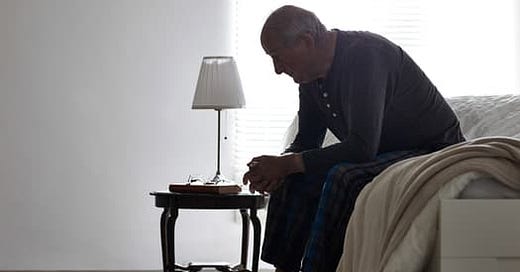Mental distress affects many with prostate cancer
It's time to take action on anxious surveillance
By Howard Wolinsky
The combination of mental distress and prostate cancer (all along the spectrum of PCa) is a major issue.
I just wrote an article today for WebMD on this topic, Mental Distress: Prostate Cancer’s ‘Elephant in the Room’ and thought you'd find it of interest.
It opens like this:
Mark Lichty, 73, said it took a decade for him to overcome the anxiety, fear of death, and uncertainty about the future after he was diagnosed with low-grade prostate cancer in 2005.
Lichty, of East Stroudsburg, PA, channeled some of this anxious energy into launching Active Surveillance Patients International (ASPI), which he co-founded in 2017 to help men with low-risk prostate tumors to cope with the worry that their condition may evolve from benign to life-threatening.
Many men have taken to calling this state of limbo “anxious surveillance” – a baseline level of concern that gets worse while they await the results of periodic blood tests that, depending on the results, can signal the need for surgery or radiation therapy to remove a tumor that’s become more aggressive.
Ironically, Lichty says, those same tests – which look at levels of a protein called prostate-specific antigen, or PSA – led to an “epidemic of overdiagnosis” of prostate cancer in the 1990s. That in turn led to overtreatment that resulted in erectile dysfunction, incontinence, and other problems for many patients – and now, he says, “the epidemic of anxious surveillance that can result in unnecessary distress in these patients and even in more overtreatment.”
To read the rest, go to: https://www.webmd.com/prostate-cancer/news/20221102/mental-distress-prostate-cancer-elephant-room
Meanwhile, ASPI, AnCan, PCRI, Prostate Cancer Support Canada, and TheActiveSurveillor.com newsletter are finishing a survey that takes a deep dive into mental distress and active surveillance.
We have 400 (actually 399 at the moment) respondents and hope for more. Some very interesting insights will be coming out of this survey.
The survey is open to patients on AS for low-risk Gleason 6 prostate cancer to favorable intermediate-risk prostate cancer as well as to those who have moved on to treatment,
Please answer the survey. It takes about five minutes and will add to the Patient Voice on pressing issues.
We close on Nov. 15. To participate in the survey, click here: https://www.surveymonkey.com/r/W69XXDS
Data will be used to inform policymakers, guideline writers, researchers, and clinicians about where we patients stand on key issues, such as distress, whether Gleason 6 should be renamed as a noncancer, and transperineal v. transrectal biopsies.
Moving AS to the next level
By Howard Wolinsky
The Active Surveillance Coalition, a collaboration of leading support groups for active surveillance (AS) for prostate cancer, is sponsoring a webinar at 9 a.m. Vancouver/12 p.m. New York/5 p.m. London/6 p.m. Amsterdam on Thursday, Nov. 17 to discuss how we can move the needle on AS, close monitoring of prostate cancer.
AS leaders from Sweden, Holland, the United Kingdom, and the state of Michigan’s will share their “secret sauce” for reaching AS rates of near 90% and above.
The free webinar is entitled “Moving AS to the next level: Can we help more patients?”
Register here: https://bit.ly/ASnextlevel
The United States has lagged behind other wealthy countries in AS acceptance though the approach started here and in Canada in the late 1990s. AS uptake with AS finally reached a majority of 60% in 2021. The American Urological Association in 2022 set a new goal of 80% In 2010, only 6% of patients qualified for AS opted for this approach.
Several European countries and the state of Michigan’s MUSIC (Michigan Urological Surgery Improvement Collaborative) program have reached AS uptakes of around 90% or higher.
Panel members will present their stories followed by a discussion and a Q&A involving the audience.
Sign my petition to phase out transrectal biopsies. Read why: https://chng.it/7bQsWSfK Once we hit 1,000 signatures, we should begin letting Congress, Medicare, and the American Urological Association know. Please make no donations. This effort requires your signatures, not your money—at this point.



